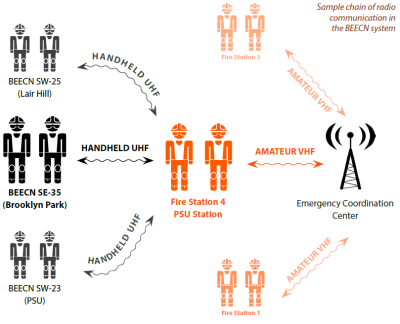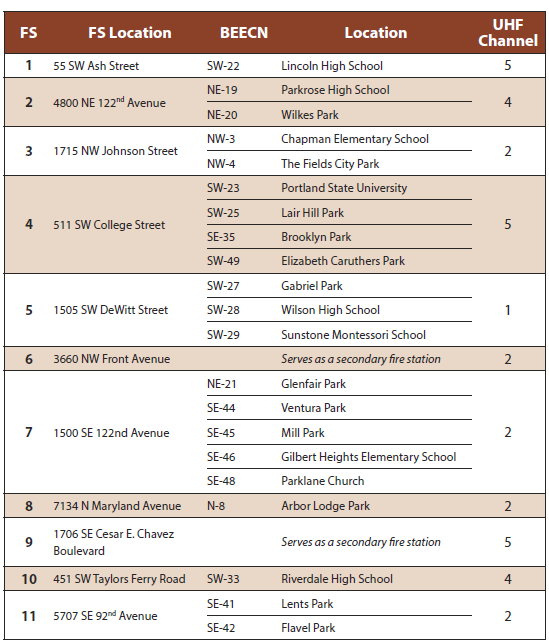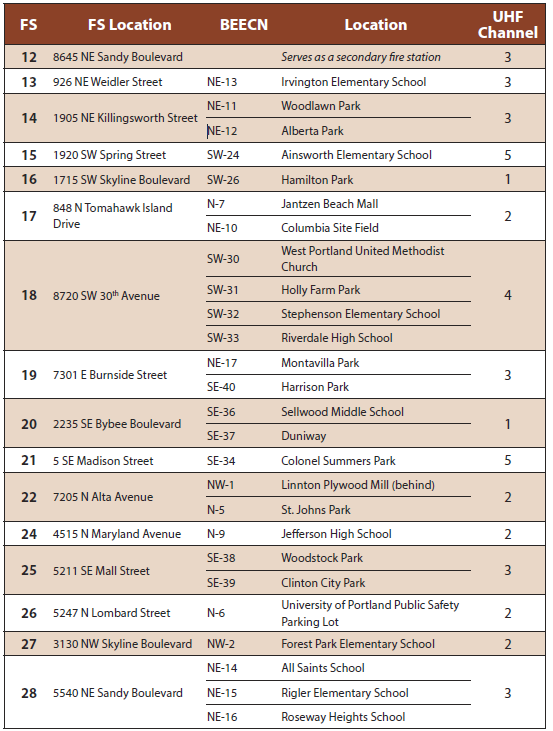Operations at Fire Stations: Difference between revisions
BruceSchafer (talk | contribs) m (→400.40 Basic Fire Station Operations: Removed extra spaces) |
BruceSchafer (talk | contribs) (→400.55 Amateur radio script for fire station ARO to Net Control (ECC): Added links to BEECN Scripts page) |
||
| Line 107: | Line 107: | ||
=== 400.55 Amateur radio script for fire station ARO to Net Control (ECC) === | === 400.55 Amateur radio script for fire station ARO to Net Control (ECC) === | ||
Scripts | See [[BEECN Scripts]]. | ||
=== 400.60 Fire Station BEECN Activity Demobilization === | === 400.60 Fire Station BEECN Activity Demobilization === | ||
Revision as of 17:40, 2 November 2023
This section steps volunteers through what to do when deployed to a fire station to support BEECNs in an emergency or during an exercise. Operations for volunteers who deploy to BEECN sites are covered in Operations: BEECN Sites.
400.05 Fire Station Volunteers: General Objectives
In the event of a deployment, Fire Station cohorts:
a. Stay safe, and will abort their deployment if they feel unsafe.
b. Deploy to their assigned fire station to access the orange VHF Go-Kit (See Equipment Caches BEECN Radio Go KitEquipment_Caches#BEECN_Radio_Go_Kit for equipment details).
c. Set up the Go-Kit at the fire station, as well as the handheld UHF radio.
d. Pass radio traffic between nearby BEECNs and net control at the city’s ECC.
400.10 Deployment Planning
Have a plan. Cohorts must consider that an earthquake knocking out communications systems means volunteers will be unable to check in with each other. Therefore, cohorts must plan ahead on who deploys for the first 8-hour shift, and who for the second. Furthermore, all four volunteers (Primary and Backup) assigned to a shift should deploy for that shift if they can. If one or both Primary volunteers cannot deploy, the Backup volunteers are still present to carry out fire station responsibilities and/or assist the Primary Volunteers if needed. Backup volunteers can also rotate Primary Volunteers out of their shift for breaks to eat, use the bathroom, etc.
PBEM recommends that the Cohort Coordinator inform local NETs of the cohort’s deployment plan. The Team ARO for a local NET may need to access the orange Go-Kit in the event of a disaster.
400.15 Responsibilities Prior to Deployment
Immediately following an earthquake, FS volunteers:
a. Check themselves for injuries and ensure personal safety.
b. Check in with household members, ensure their safety, and treat any injuries.
c. Deploy to fire station if it is safe to do so and commence operations.
400.20 Deployment Protocols
BEECNs are deployed 24 to 48 hours following a catastrophic earthquake that has shut down communications systems such as cell phones and land lines. Therefore, FS volunteers must expect to self deploy without a direct request from PBEM or other government authority. FS volunteers deploy to their assigned fire station and set up the Go-Kit if, and only if, the following conditions are met:
a. No less than 24 hours have passed since a catastrophic earthquake.
b. The volunteer and his or her family are not in any immediate danger, and are not injured.
c. Communication systems (such as land lines) are inoperative.
d. Volunteers have received no direct instructions from PBEM or other government authority.
400.25 Self Determination to Deploy
Individual volunteers maintain personal discretion to deploy when the self- deployment protocols are met as described in 400.20. The decision to deploy following a disaster is a volunteer’s own, and a volunteer may never be coerced into deploying. A volunteer who chooses not to deploy will not be subject to any consequences related to his or her standing in the BEECN program.
400.30 Deployment Guiding Principles
During the course of any deployment or exercise, FS volunteers must ensure that all chosen actions conform to the following guiding principles:
a. Safety is always the top priority.
b. Use the buddy system and always work in pairs. It takes at least two volunteers to relay radio traffic from the fire station.
c. If you see something unsafe, say so. Everyone has permission to say, “That does not seem safe” or “I do not feel safe.”
d. If someone points out an unsafe condition, stop and correct it right away.
400.35 Conduct at the Fire Station
a. When arriving at the fire station, volunteers should act as guests on the property. Please be respectful and avoid damaging equipment or property at the station.
b. Credentials are required in order to access to the VHF kit. Fire station staff are instructed NOT to give volunteers access unless they possess an official PBEM volunteer badge.
c. Except in highly unusual circumstances (i.e. potential life safety situation at the fire station), the Go-Kit should never leave the premises of the fire station.
400.40 Basic Fire Station Operations
a. Community residents go to their nearest BEECN to send information to the Portland ECC. To accomplish this, BEECN operators send messages via a UHF handheld radio to the volunteer team at the nearest fire station, and the fire station re-broadcasts BEECN messages via amateur radio to the Portland ECC. There are at least two team members at the fire station:
- Amateur Radio Operator (FCC licensed): responsible for setup and operation of the amateur radio and communicating with the ECC. All amateur radio use and transmission must be in compliance with Federal Communications Commission (FCC) rules and regulations.
- UHF Radio Operator (no license necessary): Responsible for setup and operation of the UHF handheld radio and communicating with nearby BEECN sites.
b. FS volunteers should maintain a written log of communications to and from their station using the BEECN radio form, which is included as part of Appendix B.
c. The ARO next checks in with the ECC. The procedure for checking in with the ECC via amateur radio is as follows:
The ARO checks in with the Multnomah County Amateur Radio Emergency Service (ARES) Resource Net Controller on the Multnomah County Secondary Repeater MC-2, which is stored in memory channel 2 of VHF radio. Checking in with the Resource Net, the ARO gives his or her FCC call sign and waits for acknowledgement from the net control operator. Once recognized, the ARO then provides the following information:
- Name
- Location
- Available equipment, including communications and transportation resources
- BEECN affiliation
- Any other information deemed necessary by the ARO or requested by net control
d. If no contact is possible on the Multnomah County ARES Resource Net via the MC-2 repeater, AROs should attempt to make a simplex contact with the Resource Net using the output frequency of the MC-2 repeater: 147.280 MHz, which can be accomplished using MC-12 stored in memory channel 12.
e. After checking in with the Resource Net Controller (or attempting to check in) the ARO should switch over to the BEECN simplex frequency: 144.410 MHz, which should be stored in memory channel 20. (If changing to channel 20 causes PNTC13 to appear on the radio's display. If it doesn't, the ARO can use the radio's VFO mode to select 144.410 MHz.) The ARO will use 144.410 MHz to check in with the BEECN Tactical Net Controller sited at the ECC and provide any requested information.
f. Regular radio traffic and monitoring commences. BEECNs will request permission from the fire station to begin passing traffic. The BEECN Net Controller will contact each fire station periodically for status reports. (AROs will handle life threatening situations by calling 911 if it is available.)
g. The operator of the UHF handheld is responsible for regularly checking in with the BEECNs on their channel. This includes BEECNs on the channel not normally associated with the fire station (e.g. a BEECN whose operators cannot reach their normally assigned fire station may reach and need assistance from another).
400.45 Radio Traffic Priorities
Members of the public will have many different purposes for relaying messages through the BEECN network. If messages compete for priority, volunteers should use this guide to decide which messages get relayed soonest:
1. Fire/Life Safety: these are, essentially, 9-1-1 calls. If a BEECN receives one of these messages it takes priority over and interrupts all other radio traffic.
2. Damage Assessments and Casualty Reports: members of the public reporting significant damage to property and infrastructure, or reports of injuries and casualties. Portland Fire & Rescue will be the lead resource responsible for these.
3. Government employee check-in: Government and TriMet employees have systems in place to contact their employers. If necessary there are “Post Earthquake Employee Check In” forms included in the loose leaf notebook in each BEECN cache.
4. Person Location: this is a request from someone to help find a missing loved one. BEECN volunteers can direct people to resources but will not facilitate reunification of families, house mates or loved ones.
5. Other: Any traffic that does not fall into the above categories (e.g. media requests).
400.50 BEECN Station List
The following table indicates which BEECNs each fire station will communicate with and the UHF channel to use:
400.55 Amateur radio script for fire station ARO to Net Control (ECC)
See BEECN Scripts.
400.60 Fire Station BEECN Activity Demobilization
a. Scripts appear as Appendix A of these Guidelines.
b. Re-pack all equipment inside the orange Pelican case. If any equipment is missing, volunteers should indicate that at the end of the log along with any explanation as to why the equipment is missing. Volunteers may then leave the log inside the orange Pelican case, for PBEM to pick up later.
c. Volunteers should next return the Go-Kit to its storage area at the fire station and let PF&R staff at the station know that BEECN activities have ceased.



